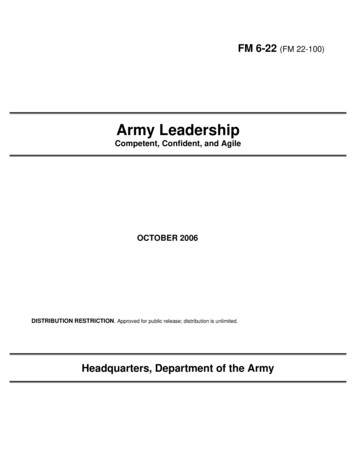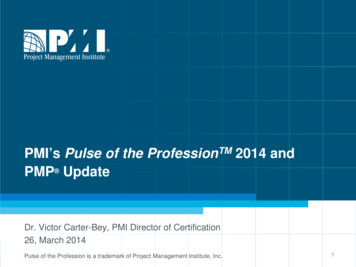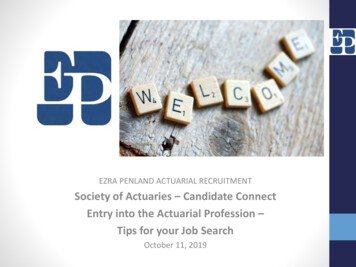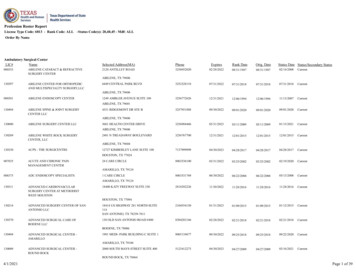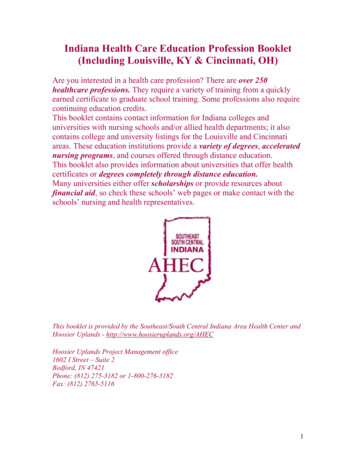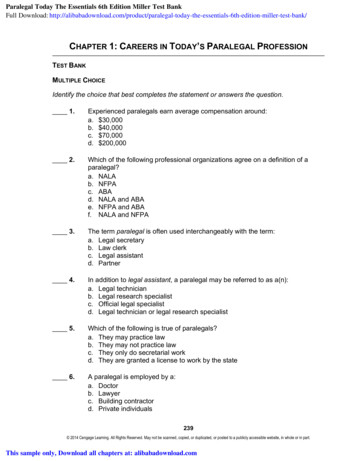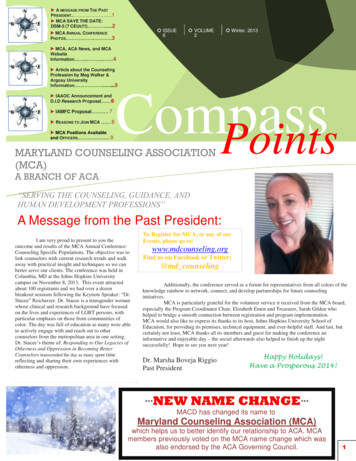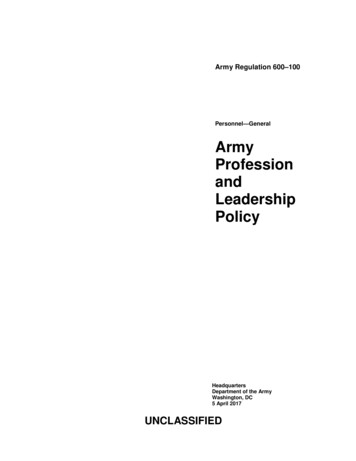
Transcription
Army Regulation rshipPolicyHeadquartersDepartment of the ArmyWashington, DC5 April 2017UNCLASSIFIED
SUMMARY of CHANGEAR 600–100Army Profession and Leadership PolicyThis major revision, dated 5 April 2017—oChanges the title from “Army Leadership” to Army Profession and Leadership Policy (cover).oChanges proponency from the Deputy Chief of Staff, G–1 to the Assistant Secretary of the Army (Manpower andReserve Affairs) (title page).oAdds policy concerning the Soldier Life Cycle (para 1–8e).oAdds policy for the Army Career Tracker (para 1–8f and app C.)oAdds the U.S. Training and Doctrine Command Civilian Acculturation Program as a best practice for Army Civilianinitial professional development (para 1–8g).oAdds a policy definition of “toxic” and “destructive” leadership (para 1–11).oAdds, updates, and clarifies responsibilities for the Assistant Secretary of the Army (Manpower and Reserve Affairs)(para 2–1).oClarifies The Inspector General duties (para 2–3).oAdds responsibilities for the Chief, Public Affairs (para 2–4).oUpdates responsibilities for the Director, Army National Guard (para 2–5).oAdds, updates, and clarifies responsibilities for the Assistant G–1 for civilian personnel (para 2–6).oChanges the staff policy proponent for the Multi-Source Assessment and Feedback program to the Deputy Chief ofStaff, G–1 (para 2–6n).oRemoves responsibilities for Commanding General, U.S. Army Accessions Command (previously para 2–9).oClarifies The Judge Advocate General duties (para 2–10).oClarifies The Chief of Chaplains duties (para 2–11).oAdds, updates, and clarifies responsibilities for the Commanding General, U.S. Army Forces Command (para 2–12).oAdds responsibilities for the Director, Institute for Noncommissioned Officer Professional Development (para 2–13).oIdentifies Deputy Commanding General, Initial Military Training as the responsible entity for common core tasks(para 2–13l).oAdds the Basic Strategic Art Program and the Joint Force Land Component Commander course (para 2–13m(13)).
oAdds the Center for the Army Profession and Ethic (through the U.S. Training and Doctrine Command/CombinedArms Center) as the lead for the Army Profession, Army Ethic, and Character Development (para 2–13p).oAdds responsibilities for Commandant, U.S. Army Sergeants Major Academy (para 2–16).oAdds responsibilities for U.S. Army Warrant Officer Career College (para 2–17).oIncorporates Army Directive 2016–06 (app B).oAdds an Internal Control Evaluation (app D).oAdds policy pertaining to the Army Profession (throughout).oUpdates the term “Department of the Army civilians” to “Army Civilians” (throughout).
HeadquartersDepartment of the ArmyWashington, DC5 April 2017*Army Regulation 600–100Effective 5 May 2017Personnel—GeneralArmy Profession and Leadership PolicyHistory.vision.This publication is a major re-Summary. This regulation prescribesArmy Profession and leadership policy andsets forth responsibilities for all aspects ofArmy Profession and leadership doctrine,training, and research.Applicability. This regulation appliesto the Active Army, the Army NationalGuard/Army National Guard of the UnitedStates, the U.S. Army Reserve and theArmy Civilian Corps, unless otherwisestated. During mobilization, the proponent,Assistant Secretary of the Army (Manpower and Reserve Affairs), may modifychapters and policies contained in this regulation.Army internal control process. Thisregulation contains internal control provisions in accordance with AR 11–2 and identifies key internal controls that must beevaluated (see appendix D).Proponent and exception authority.The proponent of this regulation is the Assistant Secretary of the Army (Manpowerand Reserve Affairs). The proponent hasthe authority to approve exceptions orwaivers to this regulation that are consistentwith controlling law and regulations. Theproponent may delegate this approval authority, in writing, to a division chief withinthe proponent agency or its direct reportingunit or field operating agency, in the gradeof colonel or the civilian equivalent. Activities may request a waiver to this regulationby providing justification that includes afull analysis of the expected benefits andmust include formal review by the activity'ssenior legal officer. All waiver requests willbe endorsed by the commander or seniorleader of the requesting activity and forwarded through their higher headquarters tothe policy proponent. Refer to AR 25–30for specific guidance.Supplementation. Supplementationof this regulation and establishment ofagency, command, and installation formsare prohibited without prior approval fromAssistant Secretary of the Army (Manpower and Reserve Affairs), 300 ArmyPentagon, Washington, DC 20310–0300.Suggestedimprovements. Usersare invited to send comments and suggestedimprovements on DA Form 2028 (Recommended Changes to Publications and BlankForms) directly to the Assistant Secretaryof the Army (Manpower and Reserve Affairs), 300 Army Pentagon, Washington,DC 20310–0300.Distribution. This regulation is available in electronic media only and is intendedfor command levels A, B, C, D, and E forthe Active Army, the Army NationalGuard/Army National Guard of the UnitedStates, and the U.S. Army Reserve.Contents (Listed by paragraph and page number)Chapter 1General, page 1Purpose 1–1, page 1References 1–2, page 1Explanation of Abbreviations and Terms 1–3, page 1Responsibilities 1–4, page 1The Army Profession and Leadership Overview 1–5, page 1The U.S. Army as a Military Profession and the Army Ethic 1–6, page 2Army Culture and Mission Command 1–7, page 2Army professional certification 1–8, page 3Army professional development 1–9, page 4Leader assessment and feedback 1–10, page 6Core leader competencies, “toxic” leadership, and destructive leadership styles 1–11, page 7*This publication supersedes AR 600-100, dated 8 March 2007.AR 600–100 5 April 2017UNCLASSIFIEDi
Contents—ContinuedChapter 2Responsibilities, page 9Assistant Secretary of the Army (Manpower and Reserve Affairs) 2–1, page 9Administrative Assistant to the Secretary of the Army 2–2, page 9The Inspector General 2–3, page 9Chief of Public Affairs 2–4, page 10Chief, National Guard Bureau 2–5, page 10Deputy Chief of Staff, G–1 2–6, page 10Deputy Chief of Staff, G–3/5/7 2–7, page 11Chief, Army Reserve 2–8, page 11The Surgeon General 2–9, page 11The Judge Advocate General 2–10, page 12Chief of Chaplains 2–11, page 12Commanding General, U.S. Army Forces Command 2–12, page 12Commanding General, U.S. Army Training and Doctrine Command 2–13, page 13Commandant, U.S. Army War College 2–14, page 16Superintendent, U. S. Military Academy 2–15, page 16Commandant, U.S. Army Sergeants Major Academy 2–16, page 17Commandant, U.S. Army Warrant Officer Career College 2–17, page 17Commanders of Army commands, Army service component commands, and direct reporting units 2–18, page 17AppendixesA. References, page 18B. Multi-Source Assessment and Feedback, page 20C. Army Career Tracker Individual Development Plan, page 25D. Internal Control Evaluation, page 27Figure ListFigure 1–1: Leadership Requirements Model (ADP 6–22), page 5GlossaryiiAR 600–100 5 April 2017
Chapter 1General1–1. PurposeThis regulation—a. Establishes Army Profession and leadership policy by defining key terms and responsibilities associated with theArmy Profession and appropriate leadership practices and methods for Soldiers and Army Civilians. This includes assigning responsibilities and definitions among the Army Profession and leadership policy proponent, the Assistant Secretaryof the Army (Manpower and Reserve Affairs) (ASA (M&RA)); the Deputy Chief of Staff (DCS), G–1; and the Armyleader development policy proponent, DCS, G–3/5/7, and Commanding General, U.S. Training and Doctrine Command(CG, TRADOC), the primary Army Profession and leadership action agent.b. Provides direction and guidance to the Center for the Army Profession and Ethic (CAPE) (through TRADOC/U.S.Army Combined Arms Center (CAC)) for research, assessment, doctrine, training, and evaluation in all areas pertainingto the Army Profession, the Army Ethic, and character development.c. Provides direction and guidance to the Center for Army Leadership (CAL) (through TRADOC/CAC) for research,doctrine development, leadership assessment, training, and evaluation in all areas pertaining to Army leadership.1–2. ReferencesSee appendix A.1–3. Explanation of Abbreviations and TermsSee the glossary.1–4. ResponsibilitiesResponsibilities are listed in chapter 2.1–5. The Army Profession and Leadership Overviewa. The mission of the United States Army is to fight and win the Nation’s wars through prompt and sustained landcombat, as part of the Joint force. We do this by organizing, equipping, and training Army Forces for prompt and sustainedcombat incident to operations on land; integrating our capabilities with those of the other Armed Services; accomplishingall missions assigned by the President, the Secretary of Defense, and combatant commanders; and remaining ready whilepreparing for the future. In the conduct of its mission, professional and diverse leaders of character, competence, andcommitment are the Army’s asymmetric advantage. This regulation focuses on leaders at all levels and in all cohorts—officers, warrant officers, noncommissioned officers (NCOs), Soldiers, and Army Civilians. These leaders are trustedArmy professionals who enable the Army to achieve the mission the right way.b. The Army Profession is a unique vocation of experts certified in the ethical design, generation, support, and application of landpower, serving under civilian authority and entrusted to defend the Constitution and the rights and interestsof the American people. The Army Profession develops, inspires, and motivates Soldiers and Army Civilians to make rightdecisions and to take right action according to the moral principles of the Army Ethic. The American people expect Armyprofessionals to provide exemplary leadership that reflects the Army Ethic and is consistent with our national values.c. The Army defines leadership as the process of influencing people by providing purpose, direction, and motivation toaccomplish the mission and improve the organization. The Army defines a leader as anyone who by virtue of assumed roleor assigned responsibility inspires and influences people to accomplish organizational goals. Army leaders motivate peopleboth inside and outside the chain of command to pursue actions, exercise diverse thinking, and shape decisions for thegreater good of the organization.d. The Army Profession contributes honorable service, military expertise, responsible stewardship, and courageousesprit de corps. These essential characteristics reinforce the sacred bond of trust within the Total Army and with the American people.e. The Army defines an Army professional as a Soldier or Army Civilian who meets the Army Profession’s certificationcriteria in character, competence, and commitment. All Army professionals are leaders and have the duty of being stewardsof the profession, regardless of their rank or official position of authority. Army professionals live by and uphold the ArmyEthic in accomplishing the mission, doing their duty, and in all aspects of life. This applies to our day-to-day interactions,at the office, in the field, on deployment, and at home, both in person and across social media. Army professionals, asleaders, must maintain and set the example in all they do. Professional and leader development is a life-long continuousAR 600–100 5 April 20171
process, consisting of education, training, experience, and self-development. Army professionals strive to continuouslyimprove their own knowledge, skills, and abilities, and as leaders they teach, coach, counsel, and mentor their subordinates.Professional and leader competence includes gaining knowledge in four primary fields: human and leader development,moral-ethical, tactical, and technical, and geo-cultural and political expertise. In addition, because Army units operate aspart of a Joint force, it is important for leaders to understand Joint, interagency, intergovernmental, and multinationalfunctions and doctrinal principles as applicable in their designated fields. Professionals keep abreast of and remain adeptin advances in their chosen career field, information technology, and maintain their knowledge of the standards of conduct,policy, law, rules of engagement, and the Geneva Conventions.f. Army leaders understand the strategic implications of their decisions and actions and contribute their best efforts toaccomplish the mission while taking care of the welfare of their subordinates. They understand that leader misconduct orunethical practice must be prevented or stopped and immediately redressed. All Army leaders must motivate others to dowhat is right – for its own sake – and understand that decisions and actions that violate the Army Ethic are not tolerated;any such action can compromise the mission and have strategic implications contrary to the national interest.1–6. The U.S. Army as a Military Profession and the Army Ethica. The Army Profession has two broad communities of practice—Soldiers, who are members of the Profession of Arms,and Army Civilians, members of the Army Civilian Corps. The principles of leadership, professional development, character development, and leader development are equally applicable to Soldiers and Army Civilians. As members of theprofession progress from their initial stage of development within the culture of the Army, their character, competence,and commitment are progressively evaluated and certified as Army professionals. From the ranks of Army professionals,those deemed with the greatest potential for leadership are selected for promotion, professional military education (PME),or Army Civilian education system and charged with greater responsibility.b. The Army Ethic is our professional ethic, defined as the evolving set of laws, values, and beliefs, embedded withinthe Army culture of trust that motivate and guide the conduct of trusted Army professionals who are bound together incommon moral purpose. The Army Ethic articulates our shared identity as trusted Army professionals and captures in oneplace the moral principles by which Soldiers, Army Civilians, and all leaders are expected to live by and uphold.1–7. Army Culture and Mission Commanda. Cultures are characterized by a shared set of beliefs, values, norms, and symbols that unite a group. The five essentialcharacteristics of the Army Profession – trust, military expertise, honorable service, stewardship, and esprit de corps – arevital to the Army Culture. The Army Culture is unique, even within the U.S. Armed Forces; it is a system of sharedmeaning held by Army professionals. The Army Ethic is the Heart of the Army. The U.S. Army culture of trust is bothinformed by and sustains the Army Ethic. Preservation of the peace and winning the nation’s wars are inherent in our ethos– this is Why We Serve. The ethical, effective, and efficient accomplishment of the mission is the core of our ethos – thisis How We Serve. Strategic leaders shape the Army’s culture while organizational and first-line leaders shape the climateof units and organizations. Culture is a longer lasting and more complex set of shared expectations than climate. ArmyCulture evolves slowly; it is deeply rooted in long-held beliefs passed from one generation of Soldiers to another andcommunicated in Army policies, doctrine, customs, traditions, songs, and ethos.b. In contrast to culture, organizational climate refers to the perception and attitudes of Soldiers and Army Civilians asthey interact within the culture with their peers, subordinates, and leaders. Observed policies and practices often driveclimate, reflecting the leader’s character. The greatest influence on an organization’s climate is the quality of its leadership.The commander sets the example by establishing high standards and expectations for the organization and its members.The best commanders place a high priority on personally developing their subordinate leaders, caring for the welfare ofSoldiers, Army Civilians, and their Families, while creating a rewarding climate of shared mutual trust and pride in teamcontributions to mission accomplishment. A healthy Army culture and organizational climate will exhibit six overarchingcharacteristics:(1) The organizational culture and unit climate fosters unity, cohesion, and trust in accordance with the Army Ethic.(2) The culture promotes and rewards mental agility, the ability to break from established paradigms, recognize newpatterns or circumstances, and adopt new solutions to problems.(3) The organization selects leaders and reward members who demonstrate the ability to sense and understand theenvironment quickly to exploit fleeting opportunities or counter unexpected threats.(4) The culture requires and rewards delegation of authority on the part of leaders, and the understanding and prompt,thorough execution of leader’s intent (two levels up) by subordinates.(5) The organizational culture selects and rewards leaders who provide clear priorities and focus their unit’s time andorganizational energy on their mission.2AR 600–100 5 April 2017
(6) The organizational culture is one of inclusion which demands and values diversity of knowledge and perspectivesthat members of different groups bring and shapes how the mission is accomplished.c. The Army seeks to execute mission command, both as a philosophy of command and as a warfighting function. Asdefined by Army Doctrinal Publication, mission command is the exercise of authority and direction by the commanderusing mission orders to enable disciplined initiative within the commander’s intent to empower agile and adaptive leadersin the conduct of unified land operations. Trust, critical to mission command, is the bedrock of our profession. It is theinternal organizing principle of the Army, and is what enables the decentralized decisionmaking by subordinates to operatewithin the commander’s intent. Leader actions consistent with the Army Ethic strengthen mutual trust and build cohesiveteams, enabling successful mission command. However, if leaders allow disconnects between word and deed, betweenprofessed values and actual practices, they breed cynicism, compromise mutual trust, and degrade organizational esprit decorps and individual morale.d. Our national values and moral principles are reflected in the Constitution, the Declaration of Independence, statute,the Uniform Code of Military Justice, treaties, status of forces agreements, the Law of Land Warfare, the standards ofconduct, and our creeds and mottos. By our Oath of Service we commit ourselves to these enduring American ideals andadherence to the Army Ethic. In addition, Section 3583, Title 10, United States Code, states: Requirement of exemplaryconduct. All commanding officers and others in authority in the Army are required—(1) To show in themselves a good example of virtue, honor, patriotism, and subordination;(2) To be vigilant in inspecting the conduct of all persons who are placed under their command;(3) To guard against and suppress all dissolute and immoral practices, and to correct, according to the laws and regulations of the Army, all persons who are guilty of them; and,(4) To take all necessary and proper measures, under the laws, regulations, and customs of the Army, to promote andsafeguard the morale, the physical well-being, and the general welfare of the officers and enlisted persons under theircommand or charge.1–8. Army professional certificationa. Certification is verification and validation of an Army professional’s character, competence, and commitment tofulfill responsibilities and perform assigned duties with discipline and to standard. Th
The Army defines an Army professiona l as a Soldier or Army Civilian who meets the Army Profession’s certification criteria in character, competence, and commitment. All Army professionals are leaders and have the duty of being stewards of the profession, re

